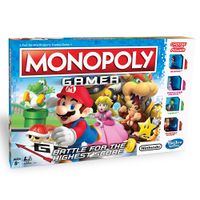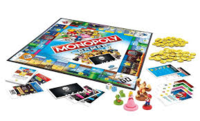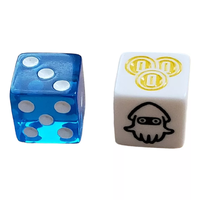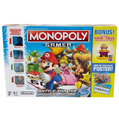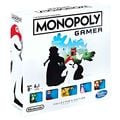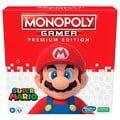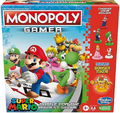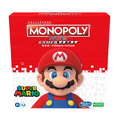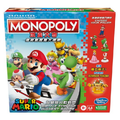Monopoly Gamer
- This article is about the Monopoly Gamer board game based on New Super Mario Bros. U. For the board game based on Mario Kart, see Monopoly Gamer: Mario Kart.
Monopoly Gamer is a series of Monopoly board game variants with themes, rules, and mechanics based on popular video games. The inaugural edition of the game was based on the Super Mario universe. While the standard edition was released in August 2017,[citation needed] a special Collector's Edition with a Bowser token and a character case was released on June 28, 2017 by Hasbro. All of the areas on the board (with the exception of Bowser's Castle) are taken from world and level names in New Super Mario Bros. U. A Mario Kart edition was released in 2018. For its third and fourth editions in 2019, the series branched out from the Super Mario franchise and Nintendo brand with Activision Blizzard's Overwatch and Sega's Sonic the Hedgehog franchises.
Gameplay
The object of the game is to earn points by collecting Coins, buying Properties, and defeating Bosses. At the end of the game, after a player defeats the final Boss, Bowser, the player with the most points wins.
Setup
First, the player needs separate the Coins by value and place them within reach of all players. Next, they need to put the Boss cards facedown in numerical order, with Boss 1, Larry Koopa, on top. They then need to place the stack of Boss cards next to the GO space. Fourth, they need to place the Title Deed Cards next to their matching board spaces. Alternatively, if the players do not have space, they should place the Title Deed Cards in a stack and choose someone to be in charge of them. Fifth, each player chooses a Character and places their Character Token on the GO space. They then should place their Character's card in fron of them. Finally, each player starts the game with five Coins, one Five Coin (worth five normal Coins), and one Reminder Card giving a short summary of the game's rules.
Like in the original game, after setting up the game, each player rolls the numbered die, with the player who rolls the highest number going first.
Turn order
On every turn, the player rolls both dice and does the following in any order:
- The player can move their Character forward the number of space rolled on the numbered die, collecting any Coins on any spaces they pass or land on, but not on the space where they start. They then should follow the rules of the space they landed on.
- The player can activate the Ability on the Power-up Die.
- At the end of their turn, if the player landed on or passed GO, they should flip over the top Boss card to start a Boss Fight.
The player's turn then ends. The player should pass the dice to the player on their left. If the player forgets to collect Coins before passing the dice to the next player, the Coins stay on the board.
Spaces
The layout of spaces is mostly the same, except with the following differences:
- The GO space prompts the player who lands on or passes it to receive 2 Coins from the Bank and initiate a "Boss Fight" by flipping over the top Boss Card on its pile.
- There are only two properties in each "Color Set" as follows:
- Brown: Acorn Plains and Yoshi's Hill (10 points each)
- Light Blue: Layer-Cake Desert and Stone-Eye Zone (10 points each)
- Maroon: Sparkling Waters and Dragoneel's Undersea Grotto (20 points each)
- Orange: Frosted Glacier & Cooligan Fields (20 points each)
- Red: Soda Jungle & Painted Swampland (30 points each)
- Yellow: Rock-Candy Mines & Waddlewing's Nest (30 points each)
- Green: Meringue Clouds & Switchback Hill (40 points each)
- Dark Blue: Peach's Castle & Bowser's Castle (50 points each)
- There are no Community Chest or Chance spaces. In their places are four Super Star Spaces and four Warp Pipe Spaces, one of each on each side of the game board.
- Landing on a Super Star Space activates the player character's Super Star Ability, listed on the Character card. Each character has a unique Super Star Ability so listed. For example, if a player using Mario lands on a Super Star Space, the player rolls the numbered die and receives the number rolled + 5 Coins (i.e. a roll of a 3 earns the player 8 Coins total.)
- Landing on a Warp Pipe Space lets the player move their character to the very next Warp Pipe space on the board. The player also collects any dropped coins on the spaces between those two Warp Pipes and on the landing Pipe (not from the departing Pipe).
- The Railroad Spaces are replaced by two ? Block Spaces (one between the brown and light blue sets, and one between the red and yellow sets) and two Thwomp Spaces (one between the maroon and orange sets, and one between the green and dark blue sets).
- Landing on a ? Block Space lets the player roll the numbered die and collect that many Coins from the Bank.
- Landing on a Thwomp Space forces that player to drop two Coins on that space.
Dice
Aside from the traditional six-sided numbered die, a six-sided Power-Up die is added. It features images of a trio of Coins on two faces, and one face each of a Green Shell, a Red Shell, a POW Block, and a Blooper. Each player rolls both dice during their turn, and can decide whether they wish to resolve their move first using the numbered die, or enact the Power-Up rolled on the Power-Up die. The base effects for rolling the Power-Up die are as follows:
- Red Shell: Choose any player to drop 3 Coins on their current space.
- Green Shell: The next player on the board (from your position) drops 3 Coins on their current space. (If more than one player is on the space, the player chooses who drops the coins).
- Blooper: Steal 2 Coins from any player.
- POW Block: All other players drop 1 Coin on their current space.
- Coins: Collect 3 Coins from the Bank.
Boss Fights
When a player passes or lands on go, they trigger a Boss Fight. At the end of their turn:
- The player should over the top Boss card and place it where all other players can see it.
- If the player wants to fight the Boss and can afford to pay the roll cost, they can do so. Most Boss cards require the player to pay the Bank, but Bowser requires them to pay the Boss. In this case, the player should place their payment on the Boss card.
- If the player chooses to not fight the Boss or is unable to pay the roll cost, they can pass, and the player on their left can fight. Once the player passes on fighting a Boss, they cannot re-enter the fight, but they can still fight other Bosses later in the game.
- The player should roll the numbered die. If the roll is equal to or higher than the required roll, the player wins and immediately carries out the Bonus on the Boss card and puts the card in front of them. If the player's roll is less than the required roll, they lose the fight, and the player to their left can either fight the boss by paying the roll cost or passing to the next player.
Players continue taking turns fighting the Boss, paying for each roll, until someone wins or until all players decide to pass. If all player pass, the Boss "gets away" and is removed from the game.
In all four editions of the game, there are eight Boss characters to defeat. The Bosses, as well as their roll costs, required roll, bonuses, and points, are listed below. In the Standard and Value Pack editions, the final boss is Bowser. Since Bowser is a player Character in the Collector's and Premium editions, he is replaced by Bowser Jr.
| Roll cost | Required roll | Bonus | Points | |
|---|---|---|---|---|
| Larry Koopa | 1 Coin | 3 or higher | Take the least expensive unowned property. | 20 points |
| Morton Koopa Jr. | 1 Coin | 4 or higher | All players must pay you 2 Coins. | 20 points |
| Wendy O. Koopa | 2 Coins | 4 or higher | Buy one Property from any player for face value. | 30 points |
| Iggy Koopa | 3 Coins | 3 or higher | Force a Property trade between any two players, including yourself. | 30 points |
| Roy Koopa | 1 Coin | 5 or higher | Send any player, including yourself, to Free Parking. Do not pass GO or pick up Coins along the way. | 40 points |
| Lemmy Koopa | 3 Coins | 5 or higher | Put any Property up for Auction. Payment goes to the bank. | 40 points |
| Ludwig von Koopa | 5 Coins | 5 or higher | Send up to two players to Jail, not including yourself. | 50 points |
| Bowser/Bowser Jr. | 1 Coin | 6 | Collect all Coins on this card. | 100 points |
End of game
The game ends immediately when the final Boss Fight is over. At this point, the player with the highest score wins. If there is a tie, then the player with the most Property and Boss cards wins.
To find out how much one scored, the player should add the points from their Property Cards, Boss cards, and Coins. Every five Coins is worth ten points.
2 or 3-player game
If the player is playing a 3-player game, when setting up the Boss deck, the player should exclude the first and second boss cards (Larry Koopa and Morton Koopa Jr.). If the player is playing a 2-player game, they should follow the basic game rules, but with these changes:
Setup
- Each player chooses two Characters and places their tokens on GO. They should then take the Character cards for those tokens and place them faceup in front of themselves with their powers showing.
- Each player starts with 20 Coins.
- When setting up the Boss deck, they should exclude the fourth and seventh Boss cards (Wendy O. Koopa and Ludwig von Koopa).
Gameplay
- On one's turn, after they roll both dice, they can choose one Character to take their turn with. At the end of that Character's turn, they should flip its Character card down. Any time a Character card is facedown, the player cannot use that Character, forcing them to use their remaining Character on their next turn. After using that Character and flipping that Character card facedown, on their following turn, they should flip them faceup again they can now choose between their two Characters again.
- Any Ability that the player activates that would normally affect all players only affects their opponent and only one of their Characters.
- If it is the player's turn and one of their Characters is In Jail, they must decide whether to pay or roll to get that Character out of Jail before rolling both dice to take their turn.
Party Mode
In Party Mode, each player can create a team of up to three Characters, swapping Characters in and out as they play.
Setup
- Each player can choose two or three Characters and take the tokens and Character cards for those Characters.
- The player should choose one of their Characters to begin the game and place their Character Token on GO. They can only have one of their Characters on the board at a time, and players can never have the same Character on the board at the same time.
Swapping Characters
The player can swap their Character on the board for one of their other Characters at any time on their turn. They can only swap once per turn, but they can swap in a way that allows one of their Characters to move and the other use its Ability.
End of game
Like in the original game, the game ends immediately when the final Boss Fight is over. All players should count up their points like in the original game.
Characters
- The basic or "Standard Edition" of the game comes with Mario, Princess Peach, Yoshi, and Donkey Kong movers as playable Characters. Other Characters can be obtained by purchasing "Power Packs", each containing a Character mover and their respective Character card. Eight Power Packs have been released; the Characters released as of late 2017 are Toad, Luigi, Rosalina, Tanooki Mario, Fire Mario, Diddy Kong, Wario, and Boo. Additionally, Bowser is included in the "Collector's Edition". The Characters, as well as their "Super Star Abilities" and "Power-up Boosts", are listed below:
| Super Star Ability | Power-up Boost icon | Power-up Boost | |
|---|---|---|---|
| Mario | Roll the number die. Collect that many Coins +5 from the Bank. | Coins | Collect 4 Coins from the Bank. |
| Princess Peach | Collect rent from the Bank for each Property you own. | Red Shell | Choose any player to drop 4 Coins. |
| Yoshi | Collect all Coins on the board. | Green Shell | Choodr the next player in front of or behind you to drop 3 Coins. |
| Donkey Kong | Steal 3 Coins from each player. | POW Block | All other players drop 2 Coins. |
| Wario | You may drop up to 8 Coins then move forward that many spaces. | Blooper | You may steal 5 Coins from another player if you are both on the same space. |
| Fire Mario | The next two plyers on the board each drop 4 Coins. | Green Shell | If the next player on the board is four or more spaces ahead of you, they drop 5 Coins. |
| Diddy Kong | Move up to three spaces forward or backward. | Blooper | You may steal 4 Coins from a player who is up to five spaces behind you. |
| Toad | Collect 5 Coins. Roll the numbered die, and move again. | POW Block | After players drop 1 Coin, roll the numbered die, and move again. |
| Rosalina | You may drop 5 Coins to steal another player's least expensive Property. | Coins | You may collect rent from the Bank for any one of your Properties. |
| Luigi | All other players skip their next Power-up Die roll. | Red Shell | Choose any player to drop 3 Coins. That player skips their next Power-up Die roll. |
| Boo | You may drop 3 Coins to use the Super Star Ability of any other Character on the board. | POW Block | All other players drop 1 Coin. You may advance to the space directly behind the next player on the board. Follow the rules of that space. |
| Tanooki Mario | Advanceto the next unowned Property. You may buy it. If there are no unowned properties, do nothing. | Green Shell | If there is a player on the space in front of you, they drop 5 Coins. |
Editions
Four editions of the game have been released as of late 2017:
- The basic or "Standard Edition" is packaged in a standard-size "long" game box, and includes Mario, Princess Peach, Yoshi and Donkey Kong movers as playable Characters. It also includes Character cards for all four Characters, denoting their "Super Star Abilities" and "Power-up Boosts", the game board, a deck of Title Deeds for the 16 properties on the board, a deck of eight "Boss Battle" cards, four "Reminder Cards" with quick-start rules and definitions of the Power-Up die sides, one blue die with white dots, one Power-Up die, 90 cardboard Coins (50 "Golden Coins" worth 1 coin, and 40 "Five Coins" worth five coins) and a Game Guide with rules.
- A Walmart-exclusive "Value Pack" Edition comes with all the equipment in the Standard Edition plus an additional Wario mover and Character card, and a poster with exclusive game art on one side, and reproductions of all 13 Character Cards from the various game editions.
- The "Collector's Edition" (initially exclusive to GameStop locations and ToysRUs.com) comes in a more squared-off and thicker box than the other editions. It includes all four Standard Edition movers plus an exclusive Bowser mover and Character card. Most of the other components are the same except for a larger "deluxe" Game Guide and plastic Coins in place of the cardboard ones.
- The "Premium Edition" (released in 2022) is similar to the Collector's Edition, with the squared-off and thicker packaging box, and having all of the same components from it. It includes all the Standard Edition movers (with the exception of Donkey Kong) as well as Bowser, plus additional Luigi and Toad movers and Character cards.
Gallery
Names in other languages
| Language | Name | Meaning | Notes |
|---|---|---|---|
| Japanese | モノポリー ゲーマー:スーパーマリオ[1] Monoporī Gēmā: Sūpā Mario |
Monopoly Gamer: Super Mario | |
| Chinese (traditional) | 大富翁Gamer冒險大挑戰[2] Dàfùwēng Gamer Màoxiǎn Dàtiǎozhàn |
Monopoly Gamer Adventure Challenge | Mainland China |
| 大富翁Gamer冒險大挑戰精裝版[3] Dàfùwēng Gamer Màoxiǎn Dàtiǎozhàn: Jīngzhuāngbǎn |
Monopoly Gamer Adventure Challenge: Premium Edition | Mainland China, Premium Edition | |
| 地產大亨Gamer冒險大挑戰[4] Dìchǎndàhēng Gamer Màoxiǎn Dàtiǎozhàn |
Monopoly Gamer Adventure Challenge | Taiwan | |
| 地產大亨Gamer冒險大挑戰精裝版[5] Dìchǎndàhēng Gamer Màoxiǎn Dàtiǎozhàn: Jīngzhuāngbǎn |
Monopoly Gamer Adventure Challenge: Super Mario Premium Edition | Taiwan, Premium Edition | |
| French | Monopoly Gamer[6] | - | |
| Monopoly Joueur[7] | Monopoly Gamer | Power Packs | |
| German | Monopoly Gamer[8] | - | |
| Italian | Monopoly Gamer[9] | - | |
| Polish | Monopoly Gamer[10] | - | |
| Spanish | Monopoly Gamer[11] | - |
See also
References
- ^ モノポリー ゲーマー スーパーマリオ
- ^ 大富翁 Monopoly Gamer 冒險大挑戰
- ^ Monopoly 地產大亨超級瑪利歐冒險大挑戰遊戲組(精裝版)
- ^ 地產大亨《瑪利歐冒險大挑戰》桌遊
- ^ MB智樂遊戲 地產大亨 - 超級瑪利歐冒險大挑戰(精裝)(F6107)
- ^ Monopoly Gamer - Jeu de Société - C18151010
- ^ Monopoly Gamer Edition Power 1-Pack (Random)
- ^ Hasbro Gaming C1815100 - Monopoly Gamer, Family Game
- ^ Monopoly - Gamer, C1815103
- ^ Monopoly Gamer C1815
- ^ Monopoly Gamer Hasbro Nuevo Oferta En Español Super Mario
